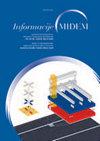Modeling of Static Negative Bias Temperature Stressing in p-channel VDMOSFETs using Least Square Method
IF 0.8
4区 工程技术
Q4 ENGINEERING, ELECTRICAL & ELECTRONIC
Informacije Midem-Journal of Microelectronics Electronic Components and Materials
Pub Date : 2020-11-20
DOI:10.33180/infmidem2020.305
引用次数: 1
Abstract
Negative bias temperature instability (NBTI) is a phenomenon commonly observed in p-channel metal-oxide semiconductor (MOS) devices simultaneously exposed to elevated temperature and negative gate voltage. This paper studies threshold voltage shift under static stress associated with the NBT stress induced buildup of both interface traps and oxide trapped charge in the commercial p-channel power VDMOSFETs IRF9520, with the goal to design an electrical model. Experiments have done with the goal to obtain data for modeling. Change of threshold voltage follow power law t n , where parameter n is different depending on the stressing phase and stressing conditions. Two modeling circuits are proposed and modeling circuit elements values are analyzed. Values of modeling circuits elements are calculated using least square method approximation conducted on obtained experimental results. Modeling results of both circuits are compared with the measured results and then further discussed.p沟道vdmosfet静态负偏置温度应力的最小二乘法建模
负偏置温度不稳定性(NBTI)是p沟道金属氧化物半导体(MOS)器件同时暴露于高温和负栅极电压下的一种常见现象。本文研究了商用p沟道功率vdmosfet IRF9520中NBT应力诱导的界面陷阱和氧化物捕获电荷积聚在静态应力下的阈值电压位移,目的是设计一个电学模型。为了获得建模所需的数据,已经进行了实验。阈值电压的变化遵循幂律t n,其中参数n随应力阶段和应力条件的不同而不同。提出了两种建模电路,并分析了建模电路的元件值。利用最小二乘法对得到的实验结果进行逼近,计算出建模电路元件的数值。将两种电路的建模结果与实测结果进行了比较,并进行了进一步的讨论。
本文章由计算机程序翻译,如有差异,请以英文原文为准。
求助全文
约1分钟内获得全文
求助全文
来源期刊
CiteScore
1.80
自引率
0.00%
发文量
10
审稿时长
>12 weeks
期刊介绍:
Informacije MIDEM publishes original research papers in the fields of microelectronics, electronic components and materials. Review papers are published upon invitation only. Scientific novelty and potential interest for a wider spectrum of readers is desired. Authors are encouraged to provide as much detail as possible for others to be able to replicate their results. Therefore, there is no page limit, provided that the text is concise and comprehensive, and any data that does not fit within a classical manuscript can be added as supplementary material.
Topics of interest include:
Microelectronics,
Semiconductor devices,
Nanotechnology,
Electronic circuits and devices,
Electronic sensors and actuators,
Microelectromechanical systems (MEMS),
Medical electronics,
Bioelectronics,
Power electronics,
Embedded system electronics,
System control electronics,
Signal processing,
Microwave and millimetre-wave techniques,
Wireless and optical communications,
Antenna technology,
Optoelectronics,
Photovoltaics,
Ceramic materials for electronic devices,
Thick and thin film materials for electronic devices.

 求助内容:
求助内容: 应助结果提醒方式:
应助结果提醒方式:


